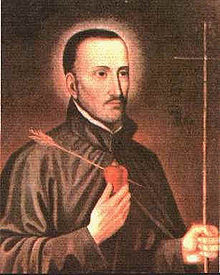White Paraguayans
 Arms of the city of Asuncion, the first European settlement in what is now Paraguay. | |
| Total population | |
|---|---|
| c. 800.000[1][2] 10% to 15% of total population | |
| Regions with significant populations | |
Ciudad del Este Encarnación San Bernardino | |
| Languages | |
| Paraguayan Spanish German (Plautdietsch, Standard German) Italian Guaraní | |
| Religion | |
| Roman Catholicism, Anabaptism, Evangelicalism, Judaism, irreligion | |
| Related ethnic groups | |
| Spaniards, Italians, Germans, White Argentines, White Brazilians |
White Paraguayans or European Paraguayans (Spanish: euro-paraguayos) are Paraguayan people whose ancestry lies within the continent of Europe, most notably Spain, Italy and Germany, and to a lesser extent, Ukraine and Poland.
Paraguayan people of European ancestry mostly descend from people who arrived over the centuries from Spain and Italy. After the War of the Triple Alliance (1864-1870) and with the the country was repopulated with the help of immigrants, mainly from European and neighboring countries.[3]
European Paraguayans are an important ethnic group representing 10% to 15% of the Paraguayan population. The vast majority of the remainder of the population is mestizo (having mixed European and indigenous ancestry, most of them of Guarani descent).[4]
History[edit]

The first known European to enter current Paraguayan territory was Portuguese explorer Aleixo Garcia. In 1537, Juan de Salazar from Spain founds a fort by the Paraguay river that he names Nuestra Señora de la Asunción (Spanish Our Lady of the Assumption) In 1570 Ruy Diaz Melgarejofrom Seville settles Villarrica and in the 1600s another Spaniard from Andalusia friar Luis de Bolaños organizes the Indian Mission of Caazapá to depart to the east towards current Brazilian territory.[5] During Spanish rule (1535-1811) Paraguay did not receive any important influx of Europeans because Spain did not have enough population and because the territory was not of particular relevance due to its lack of gold and silver. Regardless, notable white Paraguayan-born people such as Catholic missionary Roque Gonzalez de Santacruz and Spanish colonial authority Hernandarias had an importatn influence in the region.


The first important wave of Europeans to the country was after 1870 when the Paraguayan War was over and the British developed the railway system. The railway brought migrants from Italy, Spain, Rio de la Plata and some Slavs who mostly settled in the capital Asuncion.
In the 20th century after the First World War, German-speaking migrants settled in the Eastern Region and Mennonites settled in the Paraguayan West. Since the second half of the 20th century Portuguese-speaking Brazilian whites of Italian, Polish and German roots started to settle in the rural areas of the easternmost province of Alto Parana. [6] The southermost province of Itapúa on the border with Argentina received Poles, Russians and Ukrainians. Some of these slavs arrived through Argentina and others through Brazil.[7]
Numbers[edit]
Census data[edit]
The General Directorate of Statistics, Surveys and Censuses (DGEEC), the institution in charge of censuses in Paraguay, does not include the concepts of race in its surveys and only registers those people who belong to one of the officially recognized indigenous peoples. According to the 2012 Census, Indigenous people totaled 112,848 people, corresponding to 1.68% of the country's total population. This makes Euro-Paraguayans the largest minority group surpassing the Amerindians.[citation needed]
Notable Euro-Paraguayans[edit]

- Edgar Baumann - Javelin Thrower (German)
- José Bozzano - military engineer during the Chaco War (Italy)
- Ana Brun - Actress (Spain)
- Gabriel Cassaccia - novelist (Italy)
- Luis Castiglioni - 26th Vice President of Paraguay (Italian)
- Juan Francisco Decoud - Military officer during the Triple Alliance War (French)
- Joshua Durksen - Formula 2 pilot (German)
- Nadia Ferreira - International model (Portugal)
- Cayo Sila Godoy - Classical guitarrist (Spain)
- Raul Cubas Grau - 45th President of Paraguay (Spain)
- José Guggiari - 32nd President of Paraguay (Swiss)
- Juan Carlos Herken-Krauer - Economist (German)
- Luis Gonzalez Macchi - 46th President of Paraguay (Italian)
- Pedro Peña - 24th President of Paraguay (Spain)
- Alfredo Seiferheld - Author and historian (Ashkenazi Jew)
- Luis Szarán - Composer (Hungarian)
- Juan Carlos Wasmosy - 44th President of Paraguay (Hungarian)
- Sharlene Wells - Author and reporter (British)
- Robin Wood - Comic book writer (British-Australian)
See also[edit]
- White Latin American
- Italians in Paraguay
- Germans in Paraguay
- English people in Paraguay
- Ukrainians in Paraguay
- Polish Paraguayan
- Australian Paraguayans
- History of the Jews in Paraguay
References[edit]
- ^ Francisco Lizcano Fernández (2005). "Composición Étnica de las Tres Áreas Culturales del Continente Americano al Comienzo del Siglo XXI" [Ethnic Composition of the Three Cultural Areas of the American Continent at the Beginning of the 21st Century]. Convergencia. Revista de Ciencias Sociales (in Spanish). 12 (38): 185–232.
- ^ Pastore, Carlos (1972). La lucha por la tierra en el Paraguay: Proceso histórico y legislativo. Antequera. p. 526.
- ^ "Brasileños, Argentinos, Coreanos y Taiwaneses, encabezan ranking de inmigrantes en Paraguay". Hoy Paraguay (hoy.com.py) (in Spanish). 2021-12-07. Archived from the original on 17 December 2021. Retrieved 2021-12-18.
- ^ http://www.dgeec.gov.py/Censos/Imagenes/Cuestionario%20Censal.pdf?PHPSESSID=296abb7abfa015f8241d208aeaed71f4 [dead link]
- ^ ABC Digital - Etnias del Paraguay
- ^ Serge Cipko and John C. Lehr. (2006). Ukrainian Settlement in Paraguay. Prairie Perspectives, Winnipeg: University of Winnipeg, pp. 31-46
- ^ "La Hora de Polonia - Godzina Polska: Los polacos en el Paraguay". 24 July 2013.
